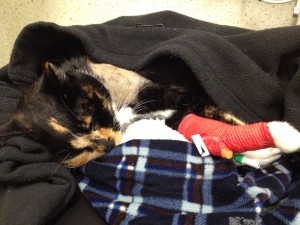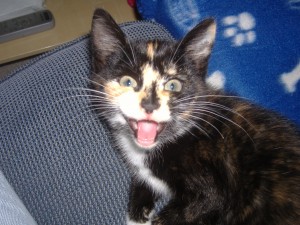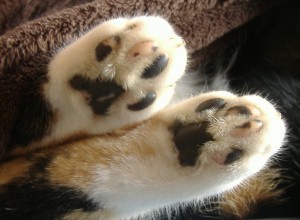Molly, and her sister Mable, were 9 weeks old when they came to live with me. Mable had always been fine. Molly on the other hand, had suffered a number of unusual health problems, and I stopped vaccinating her when she was 4 due to numerous reactions. She’d been absolutely fine for a year.
At the beginning of December 2013, I’d noticed she wasn’t eating as much as usual. One evening her behaviour was unusual. She came up on my knee, and I immediately saw that her usually pink mouth was pale. I thought I was being paranoid, but took her to the vet the next day. They could find nothing wrong, except she was anemic. Her PCV was 20% (normal in cats is around 27-45%) but they said “she doesn’t seem to be destroying her red blood cells”. In a way, they were right. A blood smear was requested, which would take two days. I took her again the following day, and her PCV was 19%. She was given Mirtazipine to stimulate her appetite. The following day I was so concerned I took her to the veterinary hospital whilst I went to work. The phone call was not good news and they had found she was non-regenerative. I agreed for her to have a chest x-ray and abdominal ultrasound. I then had an urgent call to say her PCV was now 13% and they wanted to transfer her immediately to a specialist veterinary centre. I took her there, with her sister, who was to be used as a blood donor. Fortunately the 13% was an error and her PCV was 17%. Further scans showed nothing. Her other blood lines (platelets and neutrophils) were normal. We were heading for a bone marrow biopsy.
Mable was not a match. Cats have three main blood types: A, B, and AB. Molly was type A, Mable was the rarer type B. I had concerns about the bone marrow biopsy. I was sure that nothing which it would reveal was going to be good news, and questioned whether it was in her best interests to proceed with such an invasive procedure. Still, I was assured that some of the conditions it can reveal are treatable. Her PCV continued to drop and on Sunday 8th December, they gave her an Oxyglobin transfusion to increase her oxygen carrying ability ready for her general anesthesia the following day.
Monday 9th December 2013
I received a call to inform me that Molly had come through the anesthetic safely and they had been successful in taking both a bone marrow aspirate, and a core biopsy. I went to the hospital that evening where the vet informed me that the aspirate results were “strongly suggestive of non-regenerative immune-mediated haemolytic anemia. It’s something we can treat”. I was absolutely elated. They had started her on Prednisolone and I was told there was a 75% chance she would respond to treatment. I was under no illusion about the 25% chance she wouldn’t, but for that moment I was really over the moon. They said it would take two weeks to see a response. They brought her out to see me and she was certainly frail, though they assured me she had been given plenty of analgesia. Molly had a rare form of AIHA, where her body was attacking the immature reticulocytes in her bone marrow. This meant she was not jaundiced and was not at risk of abnormal clotting.

We all hoped Molly would be able to come home a day or two later, but she continued to refuse food. I visited daily with all manner of things to tempt her, but usually only got a couple of mouthfuls in and began to realise that what was most important was for me to cuddle her, reassure her, and love her. I spent hours and hours with her. By the end of the week, she was no better and they gave her more Oxyglobin. She’d been having high fevers and they finally decided to add IV antibiotics and fluids into the mix. She had improved somewhat by Saturday and had yet more Oxyglobin, but the specialists became concerned that her spine seemed to be causing pain. The only explanation for this was the possibility of hypoxic tissue damage, due to her low red cells and inability to effectively transport oxygen.
The beginning of the end
On the morning of Sunday 15th December, the specialist called to say that she was the best she had been, and invited me to come in to see her looking so good. When I arrived, the specialist said she had become a bit quieter. When they brought her out, she was limp and exhausted. I’d never seen her look so ill and I was terrified. There was nobody about and I had no idea what to do. Finally a nurse came in and immediately checked her pulse. She was rushed back into the ward, and the specialist came out to tell me that she had now become critical and it was uncertain she would survive the night. Her PCV was 9%. I was given the option of giving her a whole blood transfusion, or having her euthanized. I opted for the blood transfusion, and within an hour a donor cat had been located and bled, and Molly was receiving her life saving transfusion. She stabilised, but I knew at this point things were not looking good.
Days passed, nothing much changed, and Molly’s PCV remained at 11%. She refused almost all food. She was started on Chlorambucil (Leukeran) but her PCV didn’t budge. The specialists began to talk more and more of euthanasia, and the original odds of 75% vanished. Having originally been told it would take two weeks for a response to treatment, I was now told it could take months. We had hit and gone past the insurance limit (this was irrelevant, I would not allow money to come into it). I had no idea what to do, and eventually decided I wanted to bring her home and give her the two weeks. I knew it was a long shot, but I was determined that her last days would be in the peace and comfort of her own home. She came home on 20th December. She was drinking and passing a lot of urine, due to the side effects of Prednisolone. All she wanted to eat was her cat litter (this was Pica, which is common in anemic cats). I had to change this rapidly, as it can be dangerous. I spent the next two days at her side, trying everything under the sun to tempt her to eat, even syringe feeding her high calorie food and water to try to keep her comfortable. By this point she hated to be picked up, and all I could do for her was brush her and stroke her, letting her know how much I loved her. Someone very wise said to me, “ask Molly what she wants”.
Sunday 22nd December, 2013
I woke up on the Sunday and I knew I couldn’t let this go on any longer. I cannot explain what changed, but I just knew.
“Ask Molly what she wants”
I had been reassured that AIHA is not a painful condition, but my girl had no enjoyment left in her life, and was not showing any signs of responding to her treatment. Her eyes were tired and I knew she was letting me know it was time to let go. Like most of us, I would have done anything to help Molly, but sadly this meant helping her to stop fighting. After discussion with various vets and family members, Molly was put to sleep on my lap at home that day. She was 6 years old. I was devastated.
I miss Molly more than words can say, but I received incredible support during her illness, which helped me not to feel so alone during a very lonely and frightening time. It also gave me the courage to keep fighting until I knew it was time. IMHA/AIHA are rare conditions and finding help, support and information is not easy. Because of what we went through, and the support I received, I am determined not to let Molly’s death be in vain, and I hope that making this information available to others will help future pets and owners facing this emotional rollercoaster. I also learnt that with the right treatment and the right information, there is hope for many animals facing this devastating disease.


